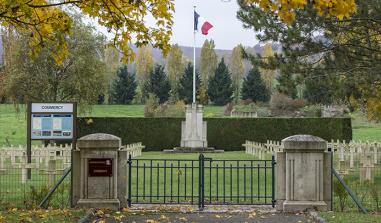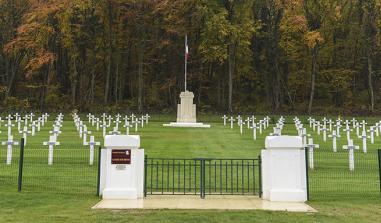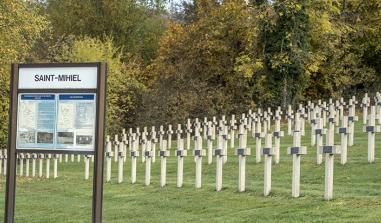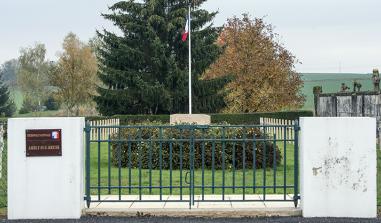Destroyed village of Haumont

The chapel and the monument for the dead. Photo by JP le Padellec
At 4 p.m. on 21 February 1916, at last the Germans attacked Haumont. The surviving French troops straightened up to contain them and stop the wrap-around manoeuvre.
History
Haumont près Samogneux is a very old village dating back to the first century of the Common Era. The Gauls had consecrated an altar to the Sun God there; later, the Romans established an entrenched camp on the same site. As its name indicates ("haut mont" means "high mount" in French), Haumont stands atop a relatively tall hill on the right-hand side of the Meuse that offers beautiful views. The place called "Le Soleil" ("The Sun"), which is in the village wood, is the highest point within the community's administrative boundaries. A Gallic altar dedicated to the sun once stood there. The Romans included the altar in an entrenched camp whose earthen levees are still visible. Big stones that ancient horsemen stepped on to help them mount their horses can still be seen along the Anglemont and Flauveau trails above the village. The soil has yielded up many ancient objects, including flint and iron weapons, coins, statuettes and bronze thanksgiving plaques. During the Carolingian period, the Roman camp and its surroundings took the name "Beuse" ("bad" in German) after the Germano-Gallic family of BOZON, which owned the Haumontois massif from Bezonvaux to Dun. The Thirty Years' War left Haumont in ruins. The lords of Haumont were the abbots of Saint-Vanne and the chapterhouse of Verdun
1914
Haumont was evacuated on 25 August 1914. The village's civilian population scattered throughout the interior of France. In late September 1914, the front stabilized in this area, leaving Brabant and Haumont inside the French lines. This sector on the right bank of the Meuse was relatively quiet. The left bank was more violent, in particular near the Forges stream. Nevertheless, Haumont underwent shelling in 1915. The village church was seriously damaged on Sunday, 7 February 1915. Here's what Corporal Maurice Brassard of the 56th Light Infantry Battalion wrote (excerpt from Verdun 1914-1918 by Jacques Pericard - page 31) Sunday 7 February 1915, Haumont's church was bombarded, a sad sight, a shell blew up the pulpit, sending splinters of wood and iron flying every which way. No more stained glass windows, six pews destroyed, the front of Saint Hubert's altar shattered, the stag has lost its antlers and lies on the floor with his crook. A brass chandelier, poles, draperies, banners, metal bouquets and debris of all kinds: glass, wood, plaster. Heaps of all these things lie strewn on the pews and the floor amidst a thick coat of dust. A piece of wood is embedded in the painting of the 12th Station of the Cross, injuring the body of Christ with a sixth wound. The harmonium is flattened against the wall.
Decisive fighting began on 20 February 1916 as the Germans began preparing their fierce attack on Verdun, especially when the operations reached the Woëvre and the left bank. People could hear the incessant fire 100 km away. It sounded like uninterrupted rolling thunder and grew louder in the following months. At 7 a.m. on 21 February 1916, as the day was just breaking and heavy snow was falling, the German infantry attacked Haumont Wood at Herbebois. (Excerpts from Verdun by Jacques Pericard, first-hand accounts by Colonel Grasset and Lieutenant-Colonel Rousset's contribution to La guerre au jour le jour) The infantrymen of the 362nd IR, commanded by Lieutenant-Colonel Bonviolle, defended the village of Haumont. The infantrymen of Haumont equalled the Chasseurs of Caures Wood. As soon as the attack began on 21 February 1916, the Germans concentrated their artillery fire on Haumont, which they suspected was one of our centres of resistance. They rained shells down with uncommon abundance on all the passages, ravines and crossroads that might be useful to us. The fire was so powerful that our forward lines gradually gave way and the Germans started overrunning Haumont Wood at around 6 p.m. The Germans attacked Haumont at 4 p.m. The equivalent of a battalion broke through in three simultaneous columns from the north, northwest and east. Those of our men who survived stiffened up to contain them and stop the outflanking manoeuvre. The machine guns that were still intact started continuously firing, mowing down the enemy's ranks.
1919 - After the war
Every year on the third Sunday in September, a mass in remembrance of our forebears is celebrated in the chapel followed by a ceremony at the monument to the dead in memory of our ancestors who lived in this place, our parents who lost everything "their homes and their land" in defence of the imperilled homeland, and the valiant soldiers who fell on the field of honour and lay buried in the ruins of our village. Those heroes gave their lives so that France might live free. In 1920, Haumont and eight other villages were included in the "red zone" (some have come back to life and have inhabitants). Building in Haumont was prohibited for the following reasons: 1° - the amount of unexploded ordnance still lying buried in the soil (it is still being found today); 2° - pollution of springs caused by dead bodies rotting in the ground (men and horses); 3° - soil contaminated by mustard gas and other pollutants. In 1920, a three-member commission appointed by the prefect managed the village. They were invested with the full powers of a mayor and municipal councillors (law of 18/10/1919).
Practical information
55100
Haumont-près-Samogneux
Accessible toute l'année







